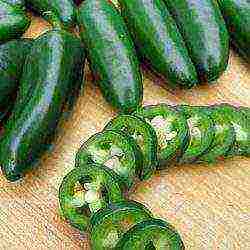Content
- 1 Shiitake cultivation methods
- 2 Substrate preparation
- 3 Sterilization of the substrate and packaging in bags
- 4 Germination of mycelium
- 5 Mushroom care and collection
- 6 Outcomes
- 7 Making blocks for shiitake
- 8 How to repopulate shiitake mycelium?
- 9 Where to keep the Shiitake substrate?
- 10 Second wave
- 11 Shiitake: benefits
Growing shiitake mushrooms at home requires careful implementation of all stages of the technology. For the preparation of the substrate, its sterilization and sowing with mycelium, some skills are needed, and for the ripening of mushrooms - a room with high air humidity, the ability to ventilate and regulate the temperature.
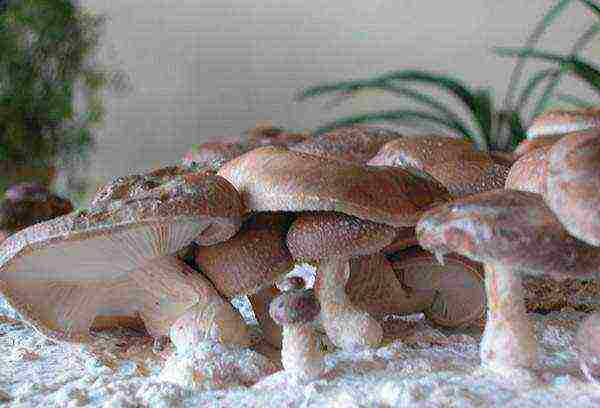
Shiitake cultivation methods
Shiitake cultivation is possible in two ways:
- intense;
- extensive.
Intensive method - sowing mycelium in a special substrate, which consists of sawdust and shavings of deciduous trees with the addition of chips, straw, hay and grain. A prerequisite for this method is the sterility of the substrate. This is because shiitake spores are weaker than mold spores. If sterility is violated, mold will drown out the multiplication of fungal spores, which will reduce the cultivation of mushrooms to nothing.
The extensive method is growing mushrooms on recently cut deciduous tree trunks. The spores are inoculated into holes drilled in the logs. The peculiarity of this method is that for the germination of the mycelium, the logs must be in conditions with low temperatures and humid air for a long time. Mushrooms grow for a long time - from the moment the trunks become infected with spores to the technical ripeness of the mushrooms, it takes from one and a half to two years.
At home, the intensive method is more effective, the mushrooms are ready to be harvested in a few months.
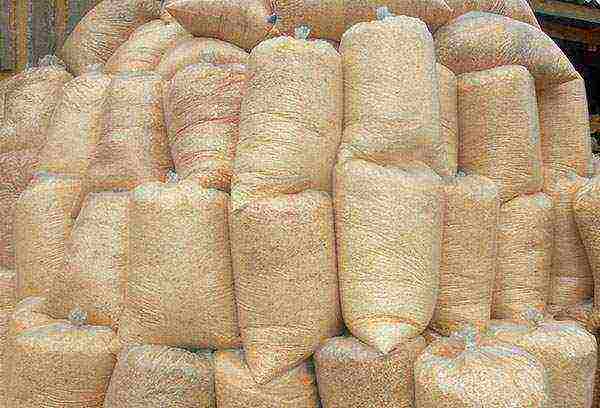
Substrate preparation
Shiitake cultivation is carried out in blocks prepared from a special substrate. This will require sawdust from deciduous trees, the fraction of which should not be less than 3 mm. For air permeability, sawdust must be mixed with shavings, small chips - also from deciduous trees. Conifers are not used because of the resins included in them, which do not allow mycelium to develop.
Instead of wood chips and shavings, you can use hay, finely chopped straw from oats or barley. Increase the nutrient value of the substrate grain, tea leaves, bean flour. Chalk or gypsum is added to improve the structure.
It has been experimentally verified that in large blocks the mycelium does not spread well throughout the entire substrate. 2.5 liters is the optimal size. When preparing a substrate at home, it is necessary to observe the proportions of the components:
- sawdust - 50%;
- straw or wood chips -25%;
- grain, bran, tea leaves, flour - 25%, in any combination;
- chalk or gypsum - no more than 1% of the total weight.
The weight in percentage can be slightly changed, but sawdust and straw combined should be at least 70%.
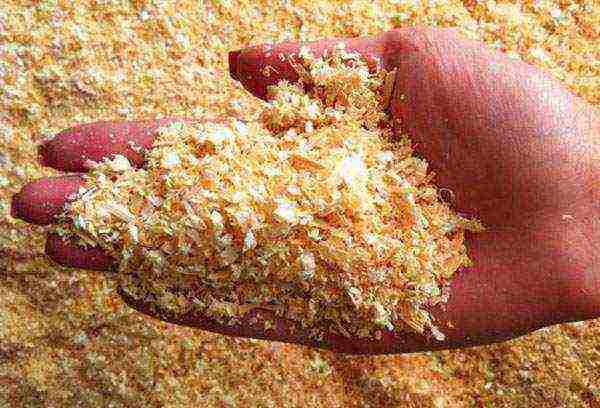
Sterilization of the substrate and packaging in bags
Growing shiitake in a substrate is impossible without first sterilizing it. The conditions in which mushrooms grow are favorable for the growth of mold, which develops rapidly and drowns out the reproduction of shiitake spores. All fungi and bacteria die in it only during sterilization.
At home, sterilization can be done in two ways:
- steam the substrate with boiling water in a separate container, and then pack it in bags;
- first pack in bags, and then sterilize in boiling water.
Sterilization in the first way, packaging and insertion of mycelium
When using the first method, you will need a large container into which the entire substrate is poured. At home, it is convenient to use an enamel pot with a lid; the dishes must be thoroughly washed beforehand. The mixture is poured to the top with boiling water, wrapped in a blanket and left for 10 hours. After that, the excess water is drained off, slightly squeezing the substrate. It should cool to room temperature under a lid, only after that it is packed in bags. Packages for packing blocks must be clean. Fill them only with sterile gloves.
Shiitake cultivation should be carried out in ventilated bags. You can do it yourself by piercing the holes on the side after forming the block, or buy special bags in which ventilation is provided.
After filling the bag, the center of the mixture is carefully pierced and the mycelium is introduced into it. The amount of mycelium should be 3-5% of the block weight. If the block has a volume of 2.5 liters, then the mycelium needs 100 or 150 grams. You cannot tie the bag tightly. Mushrooms ripen with a special gas exchange, therefore, before tying, a sterile cotton wool plug with a diameter of 2 cm is inserted into the neck. There is no need for this in ready-made bags, gas exchange will be carried out through filters.
Second method sterilization and filling with mycelium
Growing mushrooms in the second way at home is more convenient, but block bags must withstand temperatures up to + 110 °. Before packing, the mixture is moistened, wrung out and filled into bags. Moisture can be checked by squeezing the mixture in a fist:
- if trickles of water flow down, then the spin is insufficient;
- if drops stand out, the mixture is ready.
The bag is tied loosely and placed in a saucepan. Water is poured, a little short of the string. Boil over low heat for 2-3 hours. After that, the bag is removed and cooled to room temperature. Filling with mycelium is carried out in the same way as in the first case. Be sure to use sterile gloves.
The block in the package is formed in the form of a bar, the lower part of which is slightly smaller than the upper one. Mushrooms will grow at the top and sides.
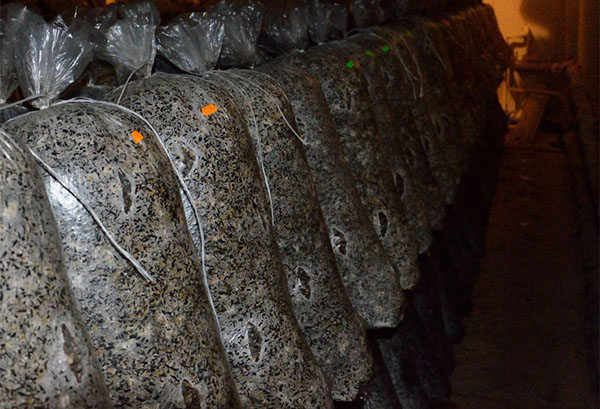
Germination of mycelium
For germination of mycelium at home, air humidity and light are not important, and the air temperature should be + 25 ° -27 °. Within two to three months, shiitake spores will fill the block. After that, it will be covered with white tubercles, and then it will turn brown. This means that the growth of the mushrooms has begun. The package must be removed from the block, and the block itself must be transferred to a room where further cultivation will be carried out.
Important!
Shiitake growth can be accelerated by placing the block in a container of cold water for a day after removing the bag. After that, excess water must be allowed to drain.
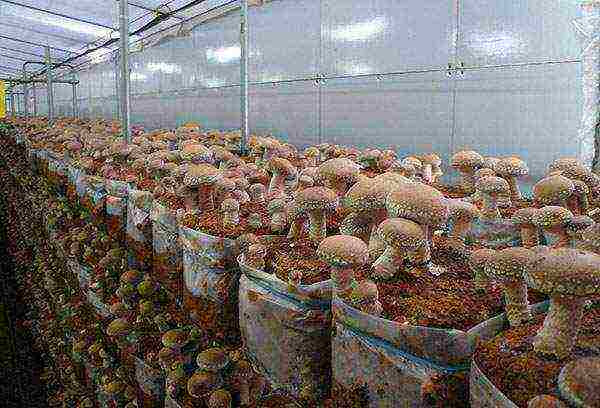
Mushroom care and collection
Mushrooms grow well only in a humid environment, with low air temperatures and good lighting.
At home, you need to create the following microclimate:
- air temperature from + 16 ° to + 20 °;
- air humidity 85%;
The room should be illuminated for about 10 hours a day. In the absence of natural light, lamps can be used. The dimmer the light, the paler the mushroom caps will be. Blocks are sprayed daily. Airing should be done regularly.
During one season, mushroom picking is carried out three times. After that, the blocks should be replaced. The readiness of mushrooms for cutting can be determined by the cap - if its edges are almost straightened, they have ceased to bend inward - the crop must be cut off.

Outcomes
A good harvest of mushrooms can be harvested only if it is possible to create suitable conditions for them. A glazed loggia or a clean basement is suitable for growing. The temperature can be regulated with a heater, equipped with forced ventilation, and to maintain humidity, use air humidifiers or constantly spray. If you ignore these requirements, then the mushrooms will not grow.
Shiitake are mushrooms with medicinal properties that grow well at home.They are picky, so experienced gardeners make a decent profit from selling them. In this article, we will explain in detail how to grow shiitake.
Shiitake fruit is continuous from May to October, but for this you will have to create acceptable conditions. In early spring, prepare the substrate by choosing whole stumps or blocks of wood. Choose trees without visible damage to the bark; stumps on which other mushrooms grow are not allowed. Try to cut off the branches before the buds appear, it is at this time that the wood contains the most nutrients and vitamins. Do not let the wood dry out. Before sowing the culture, it is necessary to boil the substrate or hold the sawn trunks for about a day in water. This will saturate the wood with moisture, which will speed up the shiitake growth process.
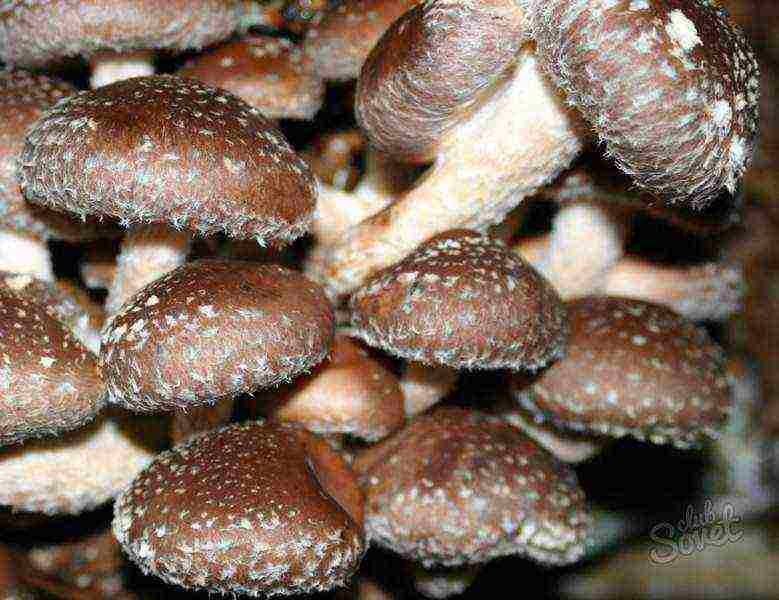
Please note that the temperature during the day in the room where the mushrooms grow should not exceed + 16 ° C. At night, the temperature can be reduced to + 10 ° C. Changing the heating level has a beneficial effect on crop growth. Now drill 6 cm deep holes in the trunks. The distance between the recesses should be no more than 10 cm. Pour mycelium into these holes and cover the holes with wet cotton wool. If you plan to grow mushrooms in your garden, bury the trunk 2/3 of its length in the ground. This will prevent the wood from drying out and allow the fungus to grow for several years.

If you are not able to use logs to grow mushrooms, you can try growing the crop in sawdust. To do this, mix sawdust with pomace or bran. This will enrich the environment for growing mushroom colonies. Before planting the mycelium, boil the sawdust in water for 1 hour, this will kill bacteria and other fungi.
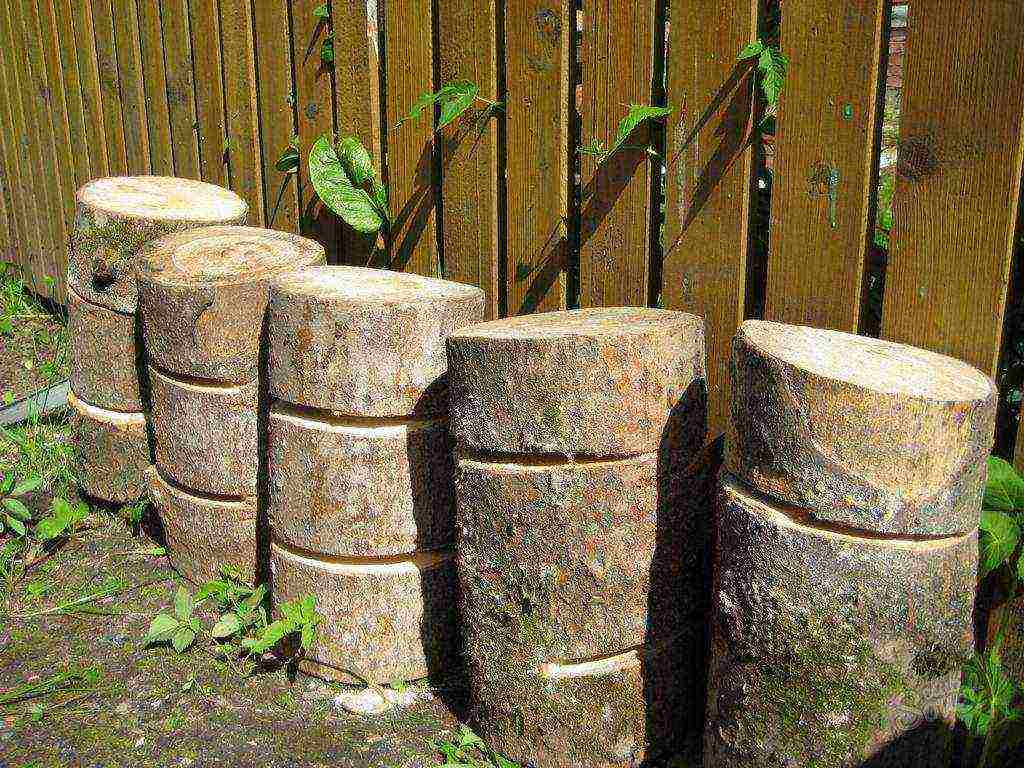
To plant mycelium, simply place it on the substrate and cover the container with plastic wrap. At the initial stage of mushroom germination, the temperature should be + 20 ° C. After mushrooms appear on the surface of the sawdust, you can reduce the heating to + 16-17 ° C. When the culture finally takes root, the substrate will turn white. You can use substrate bags for planting mycelium. Before planting the mycelium, it is necessary to make indentations with a long stick and fill them with mycelium.
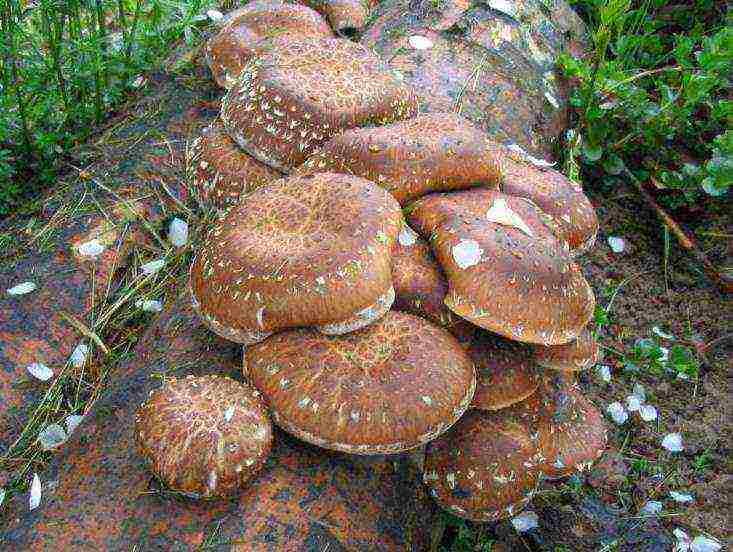
You can use straw as a substrate. To do this, it is boiled for 2 hours in a cloth bag, and then the mycelium is planted in it. It is best to stack the mycelium in layers. Place the mycelium on a layer of straw and cover it with a substrate. You can sow in three rows. In this case, you need to wait for 2-3 harvest waves.
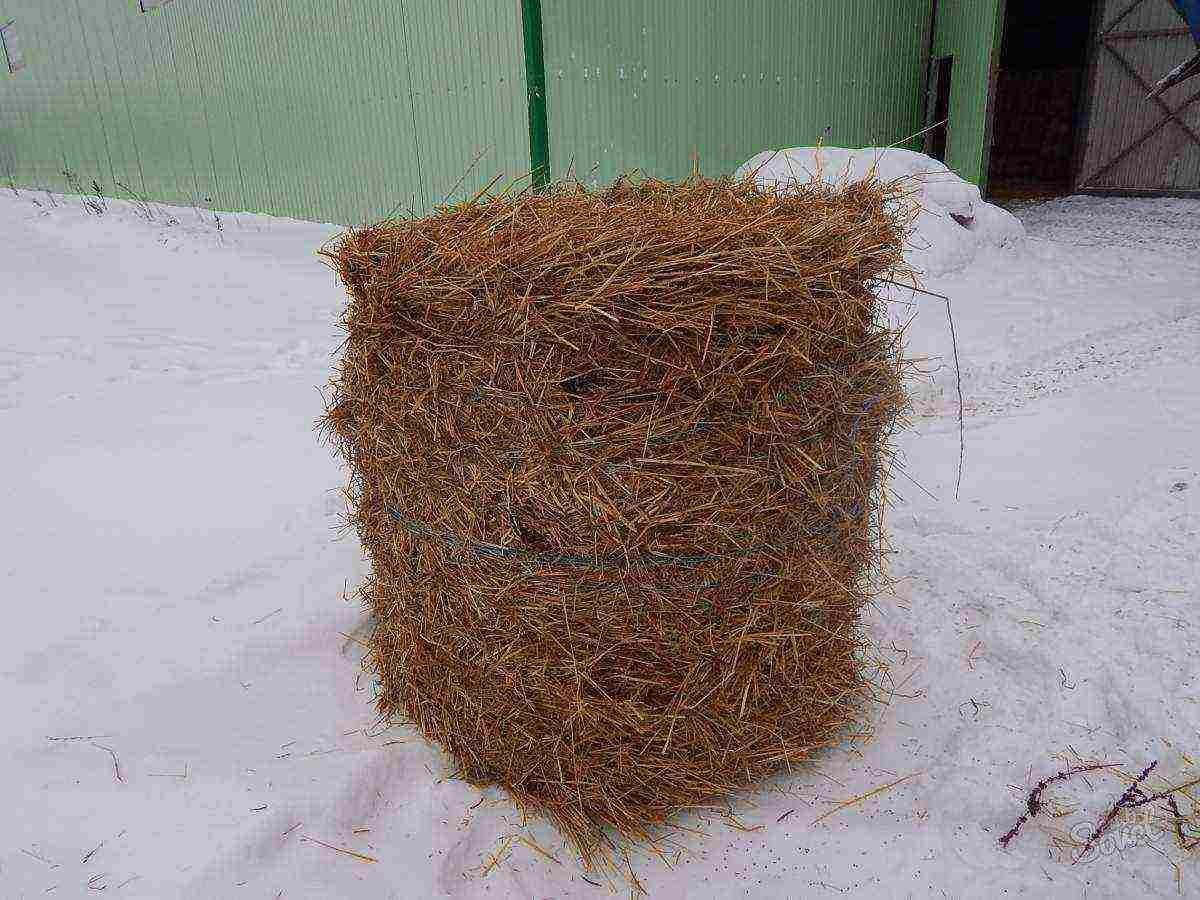
Special blocks for growing shiitake are available for sale. They already contain in their composition all the nutrients and fertilizers. There is no need to boil them before planting mycelium.
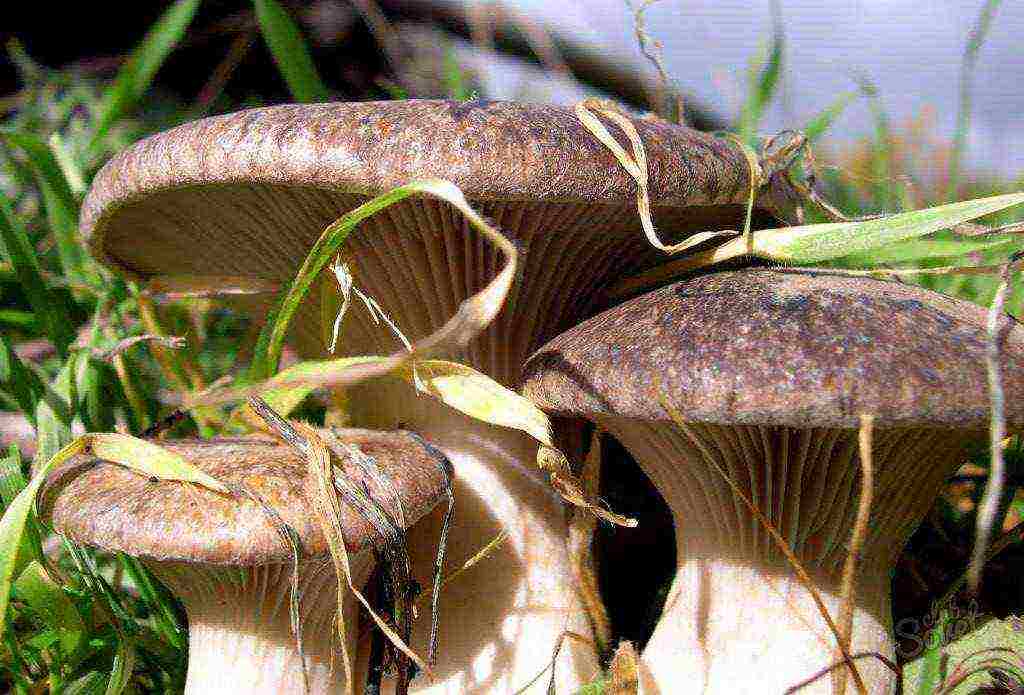
Compared to oyster mushrooms, shiitake mushrooms grow slowly, so it can take 6 months from planting to harvest. Reduce humidity to 50% before picking mushrooms. This will allow a dense film to form on the surface of the caps, which will prevent damage to the mushrooms.
After ten years of growing shiitake on pieces of wood, I decided to try to get mushrooms on a substrate from sawdust using the so-called industrial, or intensive technology. It is faster: mushrooms do not appear in a year, but two months after the introduction of the mycelium.
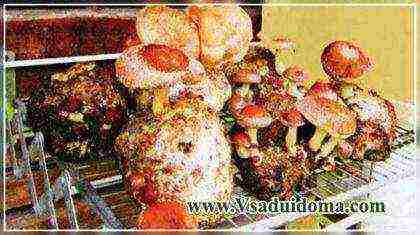
Moreover, such blocks can be placed in any room suitable for this, even on a windowsill in an apartment or in a country house under a canopy. And to grow mushrooms - at any time of the year!
Reference by topic: How to grow shiitake mushrooms (shiitake) Its beneficial properties
Making blocks for shiitake
To make the blocks, I take 4 parts of fresh sawdust (oak, birch, alder), add 1 part of wheat bran (to feed mycelium), 1% of the weight of the entire mixture of gypsum (to improve the structure of the substrate and the desired acidity) and pour it all with water in volume equal to the weight of the dry mixture.I mix thoroughly and pack, without sealing, in plastic bags of 600-700 g each. I put on sterilization for 3 hours at a temperature of + 98 ... + 100 degrees.
I do it this way: I lower the grate into a large saucepan, pour water to its level, put untied bags with the substrate on the grate, cover it with a lid (a thermometer is installed in it) and turn on a small fire. The generated steam disinfects the sawdust. After that I turn off the fire and let the sawdust cool down (I do not remove the lid). After a day, I repeat the procedure again.
How to repopulate shiitake mycelium?
I populate the blocks with mycelium (I take grain mycelium) under sterile conditions in a home "micro-laboratory". Made a sealed pencil case with glass on the top cover, a germicidal lamp and an incandescent lamp (attached to the back wall), sleeves with elastic bands on the front wall for hands (see photo).
Before the procedure, I wipe the inner walls of the chamber and the bags with the substrate with hydrogen peroxide, then turn on the bactericidal lamp for 30 minutes. I pour 3-4 tablespoons into each bag on top. mycelium, having previously scalded a spoon with boiling water (for reliability, I put it in a glass of boiling water, put it in the same box and take it out of the water in it, and when pouring the mycelium, I try not to touch the package and the substrate with a spoon). After that, I shake the bags for a more even distribution of the mycelium and tie.
Where to keep the Shiitake substrate?
The packages with the substrate should be kept in a dark place at a temperature of +22 ... + 28 degrees immediately after the mycelium is colonized.
It can be a container, a cabinet, personally, I have an old non-working refrigerator. The mycelium "colonizes" the substrate in 30-40 days. When white bulges appear, I untie the bags and put them in a bright room with a temperature of + 15 ... + 25 degrees, but avoiding direct sunlight. During this period, the first mushrooms begin to grow. As soon as they start to rest against the walls of the bag, I make small cuts in these places so that the mushrooms do not deform.
I constantly monitor each block. If the mushrooms have dried up, to increase the humidity, I put on a clean plastic bag or spray it with water (do not overdo it, otherwise mold will appear!). When the air temperature rises above +30 degrees, I take the blocks to a room with a lower temperature.
Second wave
After the first fruiting, I let the block rest for 15-30 days (I make sure that the substrate does not dry out at this time, otherwise the mycelium will die). Then I soak it in water at room temperature, dry it in the fresh air or in a ventilated room (at a temperature of + 10 ... + 17 degrees - after such stress, the mycelium "wakes up") and wait for the next wave of harvest.
See also: Growing mushrooms at home - theory and practice
Shiitake: benefits
Shiitake helps with liver diseases. Reduces the risk of stroke, atherosclerosis. It inhibits the growth of malignant tumors, strengthens the immune system, helps with chemical poisoning, and has antibacterial properties. Most effective treatment: 1 tsp. Pour 100-150 ml of warm boiled water into shiitake powder, leave for 15 minutes, stir. Drink with sediment on an empty stomach and 30 minutes before meals two to three times a day. You can drink it with water. The course of treatment is 3-4 months. Victor CHIKUENOK, fungo-therapist, Beloozersk
TIP: Usually blocks withstand 3-4 fruiting, and then become loose and fall apart. Then I make a new batch of blocks, and I sprinkle the old ones on the beds - this is an excellent fertilizer.
Below are other entries on the topic "Cottage and garden - do it yourself"
How to grow shiitake mushrooms (shiitake) Its useful properties: Growing shiitake (shiitake) - it ... How to grow mushrooms in the country - some recommendations for growing and planting: We grow oyster mushrooms, white truffles and ... Pruning raspberries and currants - master class: Regular pruning of currants and raspberries home care: Growing turmeric at home ...
Subscribe to updates in our groups.
Let's be friends!
Lentinula edible (Lentinula edodes) is a lamellar mushroom that grows on a tree.Its light or dark brown cap reaches 30 centimeters in diameter. It is attached to a white fibrous stem, cylindrical in shape. Shiitake can be translated as “broadleaf mushroom”. Its growth zone is Japan, China, Korea. "Black Forest Mushroom" can be called one of the main ingredients of most dishes of the countries of Southeast Asia. Research has revealed a large number of useful and medicinal elements in it. Growing shiitake mushrooms in the open air takes from 180 to 360 days, in a greenhouse the ripening period is much shorter.

Home business organization
The name of the cultivated culture indicates the peculiarities of the choice of soil - it is used for shiitake wood. For growing mushrooms on your own plot, you can choose intensive or extensive methods. Growing one crop under conditions close to natural takes from six months to a year. Moreover, each square meter of rotten, wet wood used for planting will bring 250 kg of a delicious mushroom every year.
Shiitake mycelium freely tolerates frosts down to -25 ° C. At the onset of spring, the place of planting of mushrooms must be covered with a film for early warming and maintaining the required moisture content of dead wood.
The optimum moisture content of the substrate is 60%, with an increase or decrease in this indicator, the yield of the mushroom place decreases.
Growing a Japanese mushroom on rotted wood trunks with a one-time replanting of mycelium in the trunk is more profitable. Fruiting mycelium will last from 3 to 5 seasons. Regardless of where the mushroom planting will be, in a horizontal or vertical position, in tiers or in one row, it is necessary to maintain the temperature and humidity of the logs.
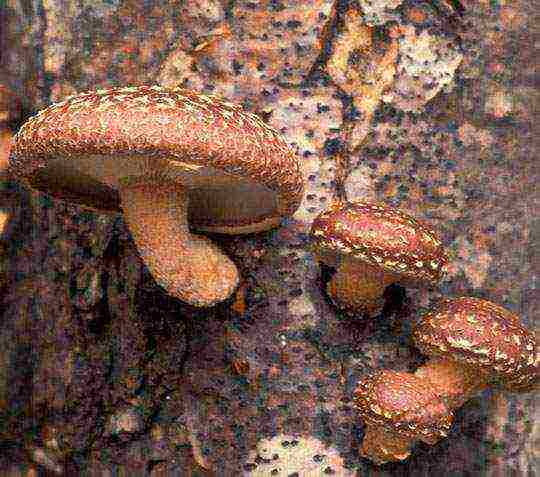
The intensive method, which requires special conditions for forcing the mushrooms, reduces the ripening period to 1-2 months. The method of accelerated germination requires strict maintenance of the temperature and moisture content of the soil (substrate). After the first outgrowth, the fruiting of the mycelium lasts for several more weeks. Only the yield with intensive forcing is no more than 20%, despite the fact that sawdust of deciduous trees and residues after threshing grain crops serve as the soil.
Attention! Softwoods are not used for mushroom cultivation. The optimal choice of substrate or blocks for planting shiitake mycelium is oak, maple, beech.
Which mushrooms are more profitable for a home business: shiitake or cherries
Growing cherries and shiitake on logs of deciduous trees that have begun to decompose from high humidity is similar only at first glance. Daily fluctuations in air temperatures in central Russia are not terrible for the Korean forest mushroom. Fruiting lasts from May until the time when there was no serious frost on the soil. As a rule, this time coincides with the holiday of the Intercession (November 14). At this time, the last root crops are removed from the fields.
- Cherries are more whimsical, their yield is lower.
- Shiitake mycelium grows much slower than oyster mushroom mycelium.
- Due to the duration of the formation period of Japanese fungi, mold begins to compete with mycelium.
- Fruiting of oyster mushrooms is provoked by a decrease in temperature.
- For shiitake, you just need to water the ridge regularly.
Having weighed all the pros and cons, it turns out that shiitake is more convenient for home cultivation. Cherries require expensive climatic equipment.
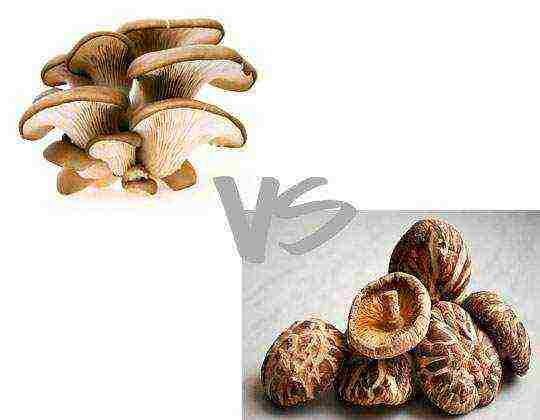
Chinese way of growing shiitake
The Chinese method of growing mushrooms on tree trunks is distinguished by the fact that logs are located with a diameter of 7-15 cm in a horizontal position. Until the middle, they sink into the ground. For convenience, the trunks of felled trees are divided into segments of 100-120 cm. If it is necessary to save space on the site, the trunks are folded according to the principle of well rings with the difference that there is a gap between adjacent logs on each side.
Preparation of trunks for planting is as follows:
- trunks during the preparation period should spend several years outdoors in rain, snow;
- the constant moisture content of the wood at the time of planting the mycelium should be 38-42%;
- the lack of moisture in the woody soil is compensated by abundant irrigation before the introduction of planting material;
- holes with a diameter of 1.2 cm are drilled on the trunk to a depth of 4 cm;
- the distance between the holes in each row is 10 cm;
- the rows are located at a distance of 7 cm from each other.
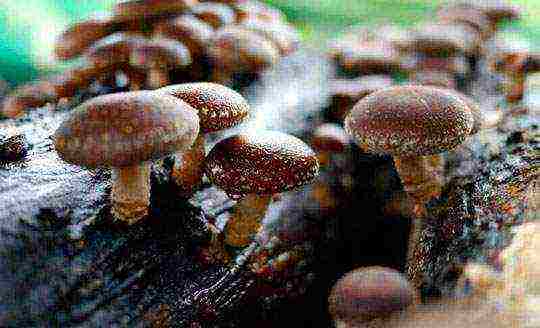
The mycelium is introduced into ready-made, sufficiently moistened holes. The height of the woodpiles, which are essentially a mushroom garden, does not matter. For 30 days, this vertical mushroom plantation must be covered with plastic wrap to create a greenhouse effect for the incubation period under it. The temperature for germination can range from +20 to + 26ᵒС.
Advice! The carbon dioxide in the wood interferes with the good fruiting of the shiitake. To get rid of it will help 12-hour soaking in water t ° from + 13 ° to +18 ° C. The absence of air bubbles at the end of the water procedure indicates the absence of CO2.
It is possible to determine the readiness of the trunks for fruiting by the following signs:
- the absence of a sonorous sound when hitting the barrel with a hammer or other solid object;
- mycelium is visible on the cuts of the trunk;
- when using halves of the trunk, white islets of mycelium in the cross section.
Growing mushrooms on trunks dug into the ground makes it easier to maintain the necessary moisture, which contributes to the natural articulation of wood. Accordingly, the temperature inside the trunk is higher than that of the surrounding soil. This means that frosts are not terrible for an impromptu mushroom ridge.
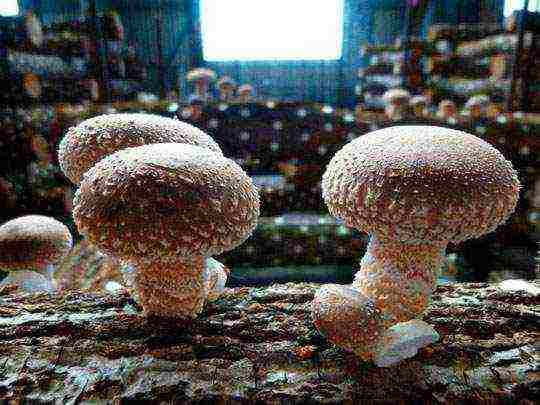
To obtain mushrooms with a dense pulp, caps and a delicate (to taste) leg are formed at temperatures low for this mushroom from +10 to +16 ° C and an air humidity of 60 to 75% uncharacteristic for many regions with a temperate climate. Daily fluctuations in air temperature also contribute to the improvement of the taste and appearance of shiitake. Therefore, during the fruiting period, the mushrooms are not covered with a film.
After collecting the mushrooms of the first growth, it is necessary to change the climate for the trunks, lowering their humidity to 30-40% and increasing the air temperature. During the 2-month recovery period, daily temperature fluctuations should be in the range from +16 to +22 ° С.
Interesting! The same logs can be used for growing shiitake for 3-5 years. During this period, mushrooms weighing 5 times less than the mass of the wood used will be collected from them. Conclusion: beech and oak have a high density and weight, which means that with the same area of birch and oak ridge, more mushrooms will be collected from the first.
Growing at home
When used for growing lentinula an edible room with adjustable modes of temperature, humidity, illumination, fruiting will be year-round. The acceleration of the forcing of mushrooms is achieved to a greater extent due to the heat treatment of the substrate.
Not all stages of industrial bending can be reproduced at home, which affects the result. Stages of work:
- the sawdust substrate is enriched with essential nutrients.
- The soil is poured into packages of agril, material for covering the beds.
- The bags with the substrate are placed in hot water for a quarter of an hour.
- The soil is sterilized for 24 hours at a temperature of 60 ° C.
- He must spend 72 hours in an environment with a temperature of 50 ° C.
- The cooled sawdust, inoculated with mycelium, is transferred to sterile 3-liter jars.
- Glass incubators are sealed with cotton stoppers.
- For 2 months, the banks are moved to a room with a temperature varying from + 17 ° С to + 20 ° С.
- The substrate with the germinated mycelium is returned to the air-permeable bags.
- No procedures are performed for two weeks. During this time, the mycelium will collect the substrate into a single dense block.
- After that, it must be sent, for about a day, to water for moistening.
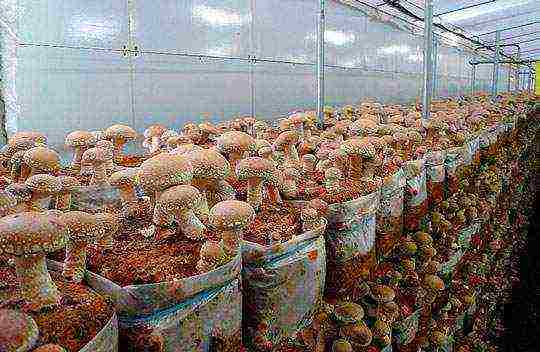
After soaking the substrate collected by the mycelium a dense block, in two weeks you can wait for the first harvest.
Making substrate blocks for household mushroom farming
It is wood that is needed to grow mushrooms, so all leaves are removed before the branches are chopped. The processed raw materials do not require additional processing, they are used immediately for the preparation of the substrate. The amount of soil is determined by the volume of the used polypropylene or agryl bag.
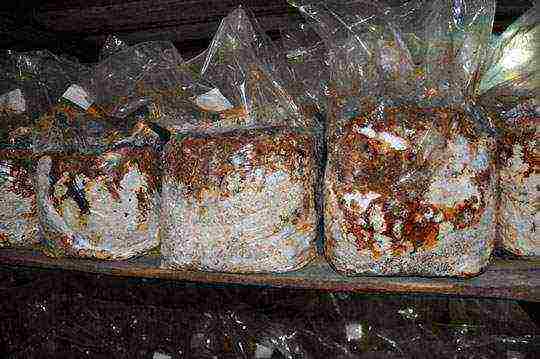
The substrate is heated and pasteurized. Only after that mycelium is planted in it. The bag is the ideal environment for mycelium development, similar to greenhouse conditions. The size and shape of the bag will determine what the substrate block will be.
Approximate calculation:
- when stuffing a package with a width of 25.5 cm, the block will turn out to be 16 s in diameter;
- optimal height - 28 cm;
- volume - 5 l;
- the wet mass has a weight of 2.2 kg.
To moisten 5 liters of sawdust substrate, 200 ml of water is enough.
Attention! Barley in the composition of the substrate increases the yield. It is recommended to add 250 g to each package. barley grains. To moisten the grain-enriched sawdust, 350 ml of water is required for each block.
You can use blocks 2 times smaller in volume to grow shiitake. Low pressure plastic bags are suitable for them. They can withstand heating temperatures up to +110 ° C.
Formation of blocks with mycelium:
- a thoroughly mixed mixture of sawdust, grain, water is packed in bags;
- from 30-40 cm of padding polyester strips, 5-7 cm wide (not used), tight rolls 2-3 cm in diameter are rolled;
- they are wrapped with threads;
- a homemade cotton plug is fixed at the top of the bag with twine or twine.
- for 8-12 hours, sealed bags are left for even distribution of moisture, grain swelling;
- when sterilizing the substrate in an autoclave, it is necessary to set the temperature regime to + + 110 ° С for 3 hours.
- after the substrate has cooled down, it is necessary to introduce the mycelium into it and close it again with a cotton plug.
Attention! Sterility should be at all stages of mushroom planting. To transfer the mycelium to the ground, it is better to use a spoon treated with a chlorine-containing composition.
One packet requires 1 tablespoon of grain mycelium. It can be poured into a bag, after tying it around a cotton plug, spread the mushroom seeds throughout the entire volume of the substrate by vigorous shaking. It remains only to give the package with loose soil a certain stable shape. The corners bent at the bottom of the bag can be fixed with tape.
Growing in a greenhouse
Growing shiitake in a greenhouse is justified in areas with cold, short summers. After thermal preparation of the substrate, introduction of nutrients into it, high-quality moisture, the blocks with mycelium are left closed for germination. After 6-10 weeks of being in greenhouse conditions at temperatures from + 17 ° C to + 22 ° C in an environment with a humidity of ≈ 55%, the bags are opened and additionally moistened.

With the frequency of watering, the first mushroom growth will not be long in coming. Shiitake will appear in 2 weeks. But until that time, it is necessary to free the substrate associated with the shiitake mycelium from polyethylene and lower the air temperature to + 10 ° С to + 16 ° С. Each block that is at this temperature for 3-6 months can be regularly harvested.
The main threat to the crop is mold inside the blocks with fungi and other microorganisms that can destroy or weaken the mycelium. It is to combat their pathogens that prolonged heat treatment of the substrate is used before planting mycelium in it.
If it is necessary to sterilize a large mass of substrate, an alternative to heat treatment of the prepackaged soil is to fry it with a total mass.True, for carrying out all the other stages, packing, distributing the mycelium, a sterile room will be required, otherwise all efforts will be in vain, because microorganisms develop much faster than the shiitake mycelium.
For greenhouse cultivation, as well as for home cultivation, dense plastic bags with a volume of 1 to 6 liters and cotton plugs are used to ensure air circulation.
Attention! For planting the mycelium, the substrate temperature should be in the range from + 20 ° C to + 30 ° C.
Preparation of planting material
To grow shiitake mushrooms in a greenhouse or at home, you need to infect some organic matter with them. The most suitable material for this is grain crops. It is most convenient to germinate mycelium in wheat or barley grains. The mycelium envelops the grains, germinating in them, as a result of which dense grain blocks are formed, infected with the mycelium.
Before inoculation - the introduction of grain mycelium into the substrate, these blocks must be kneaded into grains. The proportion of grains to soil mass is 2-5%.
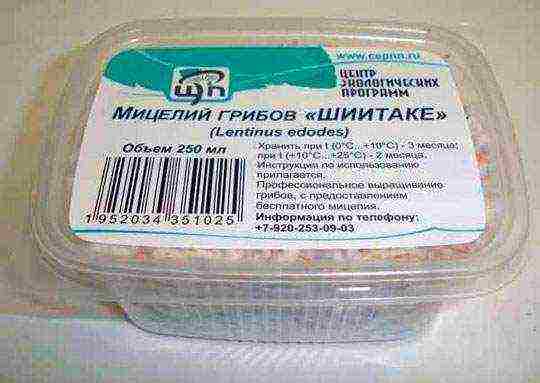
Mycelium purchase
The purchase of mycelium must be done in specialized seed stores. Here you can also purchase nutrient compositions for enriching the substrate. In the Leningrad Region, shiitake mycelium is sold by seed shops in Peterhof on Krasnye Kursantov Boulevard, 63 and in Otradnoye at the addresses: Central Street and Novaya Street, 10.
You can buy mycelium for growing shiitake in Chelyabinsk and Nizhny Novgorod, Cheboksary and Novosibirsk.
Substrate preparation
Shiitake Substrate Formulation Rules - Base, Nutritional Supplements, Acidity Optimizers. The basis is the sawdust of deciduous trees, their size should vary within 2-3 mm. Alder, aspen, birch, poplar, maple, beech, oak and other local wood species are suitable for shredding. Fungi do not grow on conifers, therefore pine and spruce sawdust is not permissible as part of the substrate.
Such a strict criterion for the size of sawdust is justified by the fact that the small ones will create a too dense layer that impedes air exchange, and there will be a lot of oxygen between the large elements of the woody soil, which is a favorable environment for the development of competitive microorganisms and mold, given the necessary humidity and temperature of the environment for growing shiitake.

No fertilizers are required for growing mushrooms! Nutrients for shiitake are cereals (their grains or flour), organic residues after threshing. Depending on what crops are grown in the area, you can use beans, corn, rice, barley. Rye, wheat, millet and so on.
The content of gypsum or chalk is permissible in the substrate. They are required to normalize the acidity of the soil. They can make up from 10 to 40% of the total volume.
Product distribution channels
Edible Japanese mushroom, resembling white champignon in taste and aroma. Its peculiarity lies in the fact that it is spicy, so the Shiitake dish does not need to add pepper. This makes it possible to sell it to factories that make semi-finished mushroom soups, sauces, seasonings for main courses. In the dried form, edible lentinula retains its useful properties and aroma, but somewhat loses its taste. The pungency remains if the raw material does not pass repeated soaking in hot water.
Raw mushrooms are used in almost all dishes of the national Japanese, Chinese, and Korean cuisine. The second, highest priority sales channel will be restaurants specializing in national dishes from Southeast Asia. Shiitake can be used, after preliminary soaking, in European dishes as an alternative to porcini mushrooms.
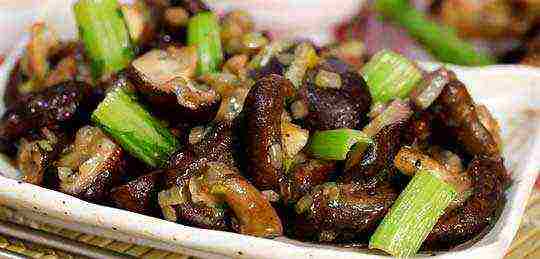
The Japanese mushroom is widely used in pharmacology and traditional medicine - this is another opportunity to establish a permanent distribution channel.The spectrum of action of the nutrients contained in shiitake is quite wide - these are:
- reduced fever;
- the fight against viruses;
- treatment of the heart and stomach;
- cleansing the blood;
- increased immunity and stress resistance;
- normalization of blood circulation;
- lowering sugar;
- breakdown of cholesterol;
- removal of toxins from the body;
- strengthening of potency.
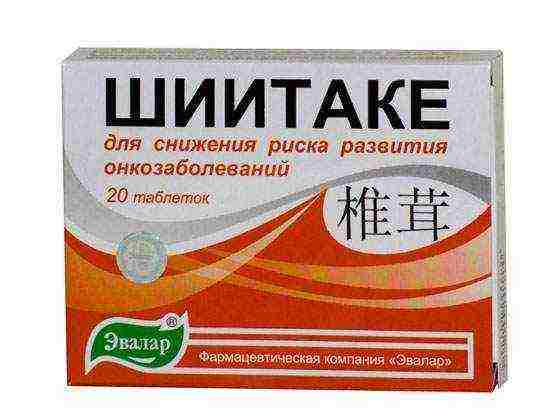
As an adjunct to the main drug treatment, shiitake is recommended for the treatment of the upper respiratory tract, poliomyelitis, smallpox, influenza, HIV. In Japan, this mushroom rich in trace elements is called the elixir of longevity. Fungal therapists recommend this mushroom for:
- cleansing the gastrointestinal tract;
- reducing excess body weight;
- to maintain normal blood sugar levels for diabetics.
Foodservice outlets specializing in diet food can also be considered as potential customers.
One of the distribution channels can be considered cosmetology concerns that use this mushroom for the preparation of anti-aging creams, lotions, masks. The benefits of shiitake in the fight against certain skin diseases have been repeatedly proven by scientists.
Costs and return on business
Competition for growing shiitake in Russia is extremely low, which at the moment explains the high cost of the product. The price of fresh mushrooms varies from 700 to 1000 rubles. per kilogram (for wholesale). For a kilogram of dried Japanese mushroom, you can gain from 2.5 to 3.5 thousand rubles. With the maximum return from one square meter of wood at the lowest prices, it will be possible to gain 175,000 rubles.
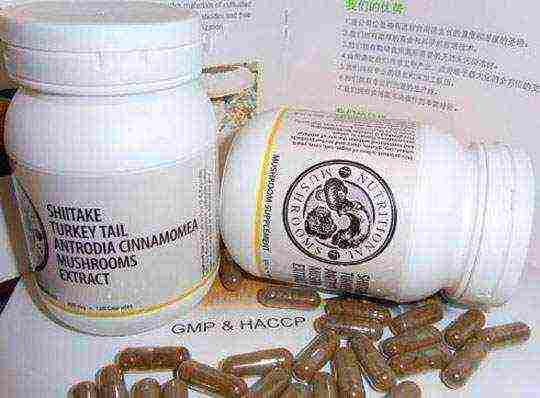
For homeowners in the private sector, harvesting the wood needed to grow shiitake will cost the cost of firewood. Deadwood is wood, for which you will have to pay a purely symbolic price when drawing up a contract for the sale and purchase of forest plantations, provided for by the Civil Code of the Russian Federation. For each family living in a house with stove heating, the state assumes a consumption of 15 cubic meters of hardwood per year.
Prices in each region are set by local authorities, on average, together with delivery, you will have to spend 5-6 thousand rubles for the purchase of wood.
- To install 3-4 square mushroom "wells", 1 cubic meter of wood is enough, which in its pure form can be equated to 400 rubles.
- Purchase of mycelium from 180 to 400 rubles,
- oats - 250-350 rubles.
- A spacious greenhouse covered with polycarbonate (if purchased in winter) costs around 15,000 rubles.
- Agrospan (agril) roll - 360 rubles.
- The cost of padding polyester depends on its density. The price of a running meter varies from 20 to 70 rubles.
All the costs of arranging a mushroom plantation are within the 20-thousandth budget, if there is an enclave and a well with drinking water on the farm. Under the most unfavorable circumstances, the recoupment of all costs is ensured from one successful transaction. Well-established distribution channels guarantee the success of your home business.
Shiitake planting technology
